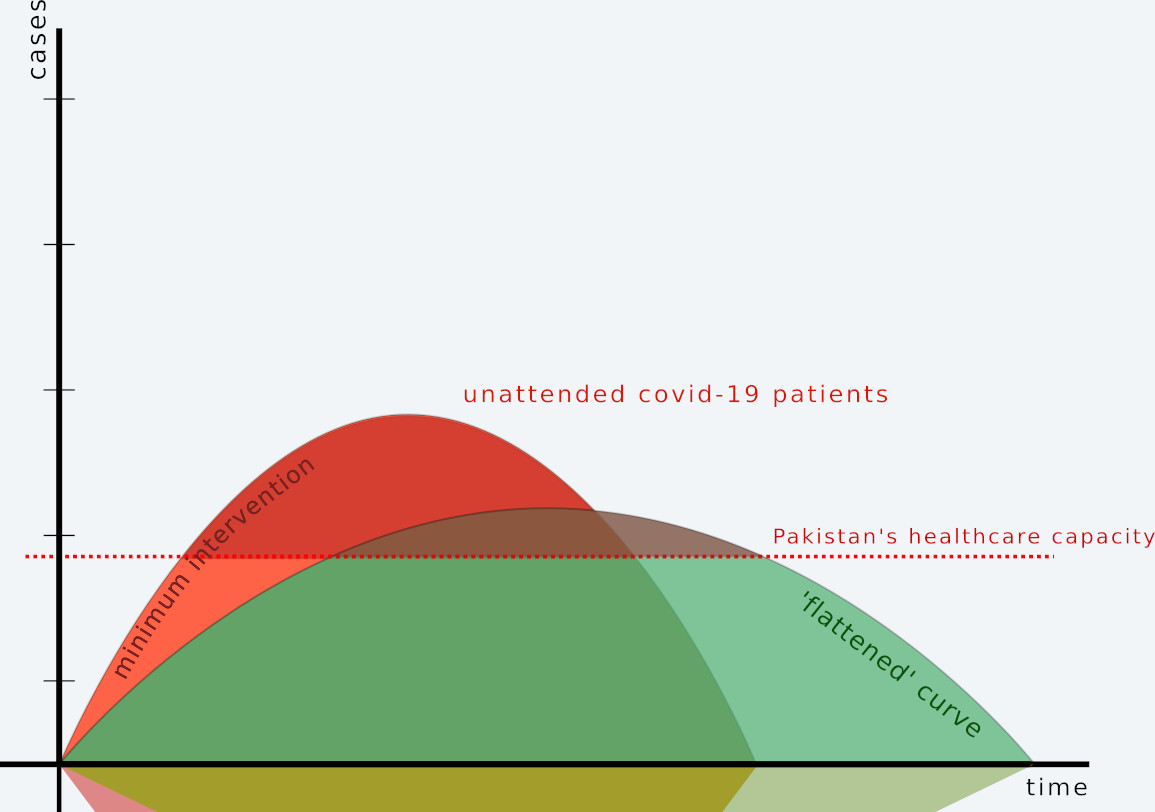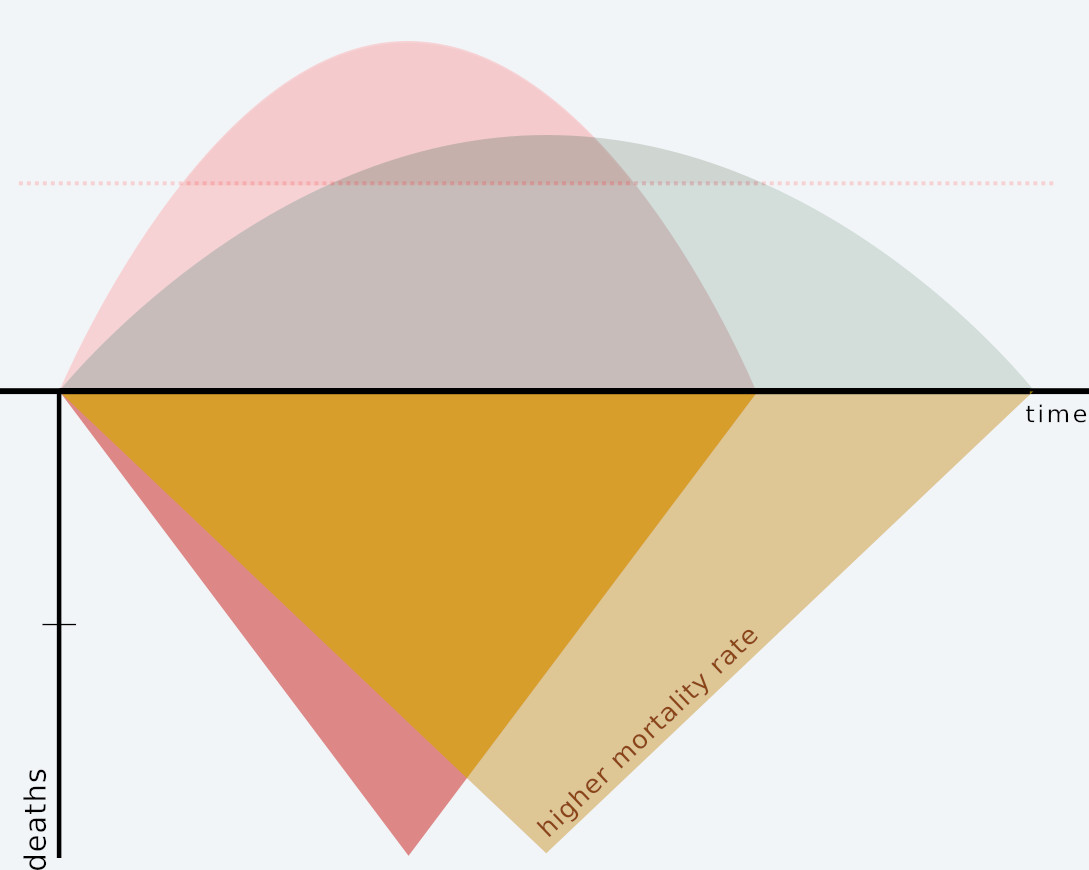Lockdown is a buzzword
Could lockdowns be worse than doing nothing?
We start from basic principles.
Before arguing for or against
- Could lockdowns be worse than doing nothing?

We start from basic principles.
Before arguing for or against it, we need to understand the purpose of a lockdown, the core of which is the concept of ‘flattening the curve’.
“The curve” is a distribution of COVID-19 cases plotted over time on the graph, with the number of infections displayed along the y-axis. You can see current status of Pakistan’s curve on Business Recorder.

The graph above shows the curve in Pakistan’s context. In general, a steeper curve means a higher number of active cases in a short period of time, while a ‘flatter’ curve would means these cases are spread over a longer duration, and the burden on healthcare system is within the manageable levels at any given time during the epidemic.
Why is a flatter curve better than a steeper one?
If a lot of people become infected with COVID-19 at the same time, many will rush to the hospital, quickly overwhelming the healthcare infrastructure. If the rate of infection is spread over a longer period of time, the healthcare facilities would be in a better position to cope. In the graph above, we suppose the red dotted line represents Pakistan’s hospital capacity. The number of patients above the line would be unable to access the healthcare they will require. The natural assumption would be that those requiring critical care, who do not even have access to adequate medical facilities, will result in higher mortality rates.
A flatter curve would eventually lead to the same number of cases, but prolonging the duration of the epidemic would lower mortality rate, while also reducing burden on the healthcare system.
Ultimately, it is all about how many lives are saved due to policy responses to the Coronavirus epidemic. Since the early days of the pandemic, Heads of States such as Angela Merkel have acknowledged that that 60-70% of populations will contract the virus, so the focus should be on minimizing number of deaths.

The figure above builds upon the original curve to explain the concept further. In a scenario with minimum interventions, an unprecedented number of patients will require medical attention, and a large proportion will remain unattended. This will result in excess mortality rates (the red curve, and the pink corresponding mortality rate shown above). In the green ‘flatter’ curve, a significantly lower number of patients are left unattended, resulting in a lower mortality rate.
It is all about saving lives.
To flatten the curve, and significantly reduce spread of coronavirus, lockdown was one of the initial responses of most countries. Lockdown, however, is not a strategy. It is a tactic. The only viable strategy it seems is to control the number of active COVID-19 cases, and keep them under levels that can be sustained by Pakistan’s healthcare infrastructure. As this oncoming train passes over us, the goal should be to keep our country’s overall death rate as close to the historic average as possible. To achieve those ends, there are plenty of policy options available. Lockdown is just one of them.
However, there are looming fears that lockdown as a sole mitigation tactic could have an overall worse impact than the minimum intervention scenario in the long run, and could possibly worsen epidemics in developing countries. These fears have been constantly voiced not only by Prime Minister Imran Khan, but also by the WHO. More recently, 37 esteemed economists from the International Growth Center (IGC) have issued a statement warning developing countries against blanket lockdowns.
“The policy responses in developed countries to the COVID-19 crisis do not provide a good model for developing countries: The imposition of extended blanket lockdowns risks causing widespread deprivation and unintended health consequences in developing countries, which are also experiencing sharp drops in commodity prices, remittances, tourism and trade and have limited fiscal and institutional capacity to support vulnerable households. The COVID-19 policy response in developing countries must take into account these factors and be tailored to the local context in each country,” they noted in the statement.
The World Food Program chief had an even more alarming statement: “In a worst-case scenario, we could be looking at famine in about three dozen countries, and in fact, in 10 of these countries we already have more than one million people per country who are on the verge of starvation.” He reiterated Pakistani Prime Minister's concern saying, “There is also a real danger that more people could potentially die from the economic impact of COVID-19 than from the virus itself.“
Two days ago Planning Minister Asad Umar warned about consequences for the Pakistani population: 10.8 million Pakistanis could be rendered jobless while, citing PIDE, he said that around 70 million Pakistanis could fall below the poverty line as a consequence. This is an astounding and unprecedented increase in poverty in a single year.
If we ignore all other factors and only take the increase in poverty into account, a blanket lockdown still looks like a horribly destructive strategy for Pakistan. An astounding 24% of Pakistanis already live below the poverty line, which roughly translates into 51 million people. Add 70 more million to this figure, and almost half of Pakistan’s population plummets below the national poverty line. Due to a strong correlation between poverty and malnutrition, coronavirus lockdowns will cause malnourishment to skyrocket. Among the many consequences of malnutrition, the most alarming is that it significantly increases the mortality rates of all diseases, and is most likely to do so for COVID-19 too.

This has been incorporated in our third figure above. If lockdowns cause enough increase in deaths not just by COVID-19, but also in those suffering from pre-existing health conditions to an extent that mortality rates in 60% of the population are increased due to poverty and malnutrition, the situation could be far worse than doing nothing about coronavirus at all.
Lockdowns could be worse than doing nothing.
However, lockdowns are not the only option for keeping the curve flatter. Subsidizing hand sanitizer, making face masks mandatory, limiting public gatherings, improving public sanitation, running disinfection campaigns, implementing social distancing measures, and broadly redesigning how citizens socially interact are some of the things the government can do to limit Coronavirus growth.
A stubborn insistence on a blanket lockdown, bringing all social and economic functions to a halt, has the potential to be increasingly destructive with every passing day. There is no blueprint of how to deal with this unprecedented situation, however, implementing solutions without analyzing all variables in the local context can be dangerous.
This has also become a political issue. While the PPP government in Sindh, and Pakistan's largest city Karachi, is pushing for a full lockdown, the Federal government and the Prime Minister Khan have pushed for a looser one. To turn it from a political issue back to a policy decision that should be based on facts, data and solid analysis, the Federal government should have to take the lead. While PM Khan has stressed on minimizing the damage to the most vulnerable sections of the society, the government has been unable to back this with data models analyzing different scenarios and taking the drastic rise in poverty into account.
Our survival depends on our ability to adapt to the new normal and move forward.
The writer is a member of the staff at the Business Recorder. You can reach him at [email protected]
Waqas Ahmed is the Senior Head of Digital Content at Business Recorder























Comments
Comments are closed.